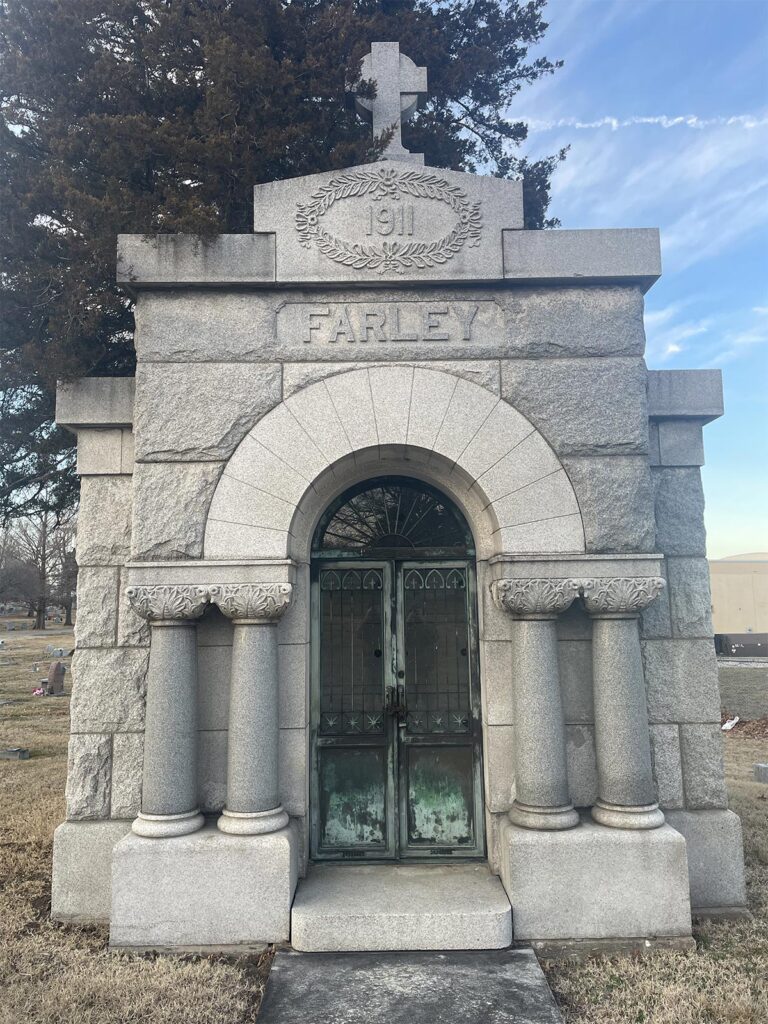COMO 365: February 1, 2007

This date in Columbia history: Columbia Cemetery and the Farley Mausoleum
On February 1, 2007, the Columbia Cemetery was placed on the National Register of Historic Places. The cemetery was established in the 1820s, just before or during the founding of Columbia in 1821. At first it was a simple common burial ground, but in 1858 the Columbia Cemetery Association expanded the area into a more formal cemetery.
The Columbia Cemetery of 2023 spans 26 acres and now includes three smaller cemeteries with separate, but closely related histories. The larger cemetery includes a section for African Americans and another section for indigent (poor) people. The list of notable interments is long, but briefly includes: James S. Rollins, William Switzler, Blind Boone, Ann Hawkins Gentry, E.W. Stephens, Walter Williams, Henry Kirklin, Jane Froman, many University of Missouri Presidents, two revolutionary war veterans, and a Missouri governor.

The Farley Mausoleum is the largest in Columbia Cemetery and has an interesting association with cemetery artwork. It was built by and for Edward Farley, a native of Ireland, who was its first interment. Farley owned a marble shop, creating and selling tombstones across mid-Missouri. The 1882 History of Boone County describes him as follows:
“In the year 1880 he came back to Columbia and erected a large brick marble shop near the court-house, where he is now actively engaged in his line of business, employing two hands besides himself; he has three agents on the road. He does work in the most artistic manner, using the finest Italian, Vermont and Pennsylvania marble; he makes tombstones and headstones at prices ranging from ten to one thousand dollars each; his work is widely known, being represented in nearly all the cemeteries of Boone and adjoining counties. He is doing a prosperous business, which is well merited and generously bestowed. In addition to his marble works, he owns considerable real estate in Columbia. Mr. Farley is a member of the Catholic church.”
The Farley Mausoleum is described by Deb Sheals in the National Register of Historic Places nomination form:
“The Farley mausoleum is the only mausoleum within the historic boundaries. (Two small later mausoleums are located in an area added to the cemetery in the 1940s.) It is located almost due north of the receiving vault, in Block 22. It is about the same size as the receiving vault, and it, too, faces south to the road. It sits back a bit from the road, and the comers of its generous lot are marked by large concrete urn planters. The planters may be newer than the building.
The Farley mausoleum is much more highly styled than the receiving vault. It is constructed of massive rock-faced granite blocks, with a high smooth stone water table, and a stepped front parapet that is topped with a small stone cross. A sculpted stone laurel wreath set into the front wall beneath the cross surrounds the date 1911, and FARLEY is spelled out in raised letters beneath the wreath. The central front doorway is topped by an oversized arch of smooth stone blocks which is supported by pairs of short smooth granite columns. The heavy capitals of the columns feature stylized acanthus leaves. The double doors of the entranceway are covered by ornamental metal grills. The building is highly intact and in very good condition.
Inspired by the preservation of Columbia’s most impressive historic mausoleum, our group, CoMo Preservation, hopes to help homeowners, landlords, and institutions prevent the destruction of historic architecture. Original period styles might be replicated, but will forever lack the social history of authentic structures. The preservation of historic buildings is necessary for Columbia’s residents, students, and visitors to achieve a sense of place and, it follows, for our city’s continued economic success. If you want to join us in our mission sign up for our mailing list to receive news and updates.
This CoMo 365 blog entry was constructed by Matt Fetterly using these sources:
- Switzler, William F. (1882). History of Boone County. St. Louis, Missouri: Western Historical Company. p.376. OCLC 2881554.
- Sheals, Debbie (August 2006). National Register of Historic Places Registration Form: Columbia Cemetery. Columbia, Missouri: United States Department of the Interior. Accessed February 1, 2023.
- Columbia Cemetery Association (2023). About Us. columbiacemetery.org. Accessed February 1, 2023.
COMO 365 is written by Matt Fetterly for comopreservation.org. The mission of COMO Preservation is to preserve the historic architecture of Columbia, Missouri. You may contact Matt at [email protected].








